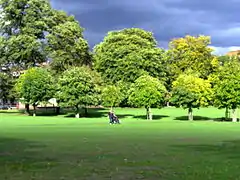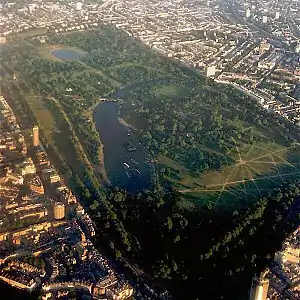Peckham Rye
Peckham Rye is an open space and road in the London Borough of Southwark in London, England. The roughly triangular open space lies to the south of Peckham town centre. It is managed by Southwark Council and consists of two congruent areas, with Peckham Rye Common to the north and Peckham Rye Park to the south.[1] The road Peckham Rye forms the western and eastern perimeter of the open space.
| Peckham Rye | |
|---|---|
 Peckham Rye Common | |
 Peckham Rye Location within Greater London | |
| London borough | |
| Ceremonial county | Greater London |
| Region | |
| Country | England |
| Sovereign state | United Kingdom |
| Police | Metropolitan |
| Fire | London |
| Ambulance | London |
| London Assembly | |
Peckham Rye is also a ward of the London Borough of Southwark,[2] forming part of the Camberwell and Peckham constituency.
Location
Peckham Rye railway station on Rye Lane is a short distance north of the open space in Peckham. To the east is Nunhead, to the south is Honor Oak and to the west is East Dulwich. Barry Road connects the Rye with Dulwich Library while Friern Road is named after an old friary.
History

It was on the Rye in the 1760s that the artist William Blake claimed to have seen visions, including one of "a tree filled with angels, bright angelic wings bespangling every bough like stars."[3]
The land for Peckham Rye Park was purchased by the London County Council for £51,000 (equivalent to £5,900,000 in 2019) and declared open on 14 May 1894. At that time the park was 54 acres (220,000 m2), 13 acres being occupied by Homestall Farm.[4] One of the first features of the new park, an ornamental 'Old English Garden' was created. It was later renamed the 'Sexby Garden' after Lt-Col JJ Sexby the London County Council's first Chief Officer of Parks. It was re-developed in 1936 and the paths re-laid with yorkstone paving.[5]
During World War II, part of the Common became a Prisoner of War camp for Italian prisoners of war.
The River Peck was largely enclosed in 1823. Today, parts of this stream can still be seen on the west side of Peckham Rye Park.
The Park includes a Japanese garden and hosts a weekly Parkrun event.
Local landmarks
 The Clock House pub on Peckham Rye
The Clock House pub on Peckham Rye The Peckham Rye bowling green (panorama)
The Peckham Rye bowling green (panorama) River Peck in Peckham Rye park
River Peck in Peckham Rye park
Cultural references
Peckham Rye is also Cockney rhyming slang for tie (necktie).
Muriel Spark's 1960 novel The Ballad of Peckham Rye tells the story of a Scotsman moving to the area.
2019 movie Blue Story makes many references to Peckham, and in particular Peckham Rye when talking about the location of rival gangs and gang warfare in the area.
2020 song Comet Face from King Krule references Peckham Rye.
References
- Southwark Council - Peckham Rye Park and Common Archived 2008-08-21 at the Wayback Machine
- Mapit https://mapit.mysociety.org/area/8325.html
- "Archived copy". Archived from the original on 18 January 2012. Retrieved 27 September 2011.CS1 maint: archived copy as title (link)
- "Opening Of Peckham-Rye Park". The Times. 15 May 1894. p. 9.
- "What a Difference a Year Makes". www.londongardenstrust.org. Archived from the original on 4 March 2016. Retrieved 25 April 2018.

